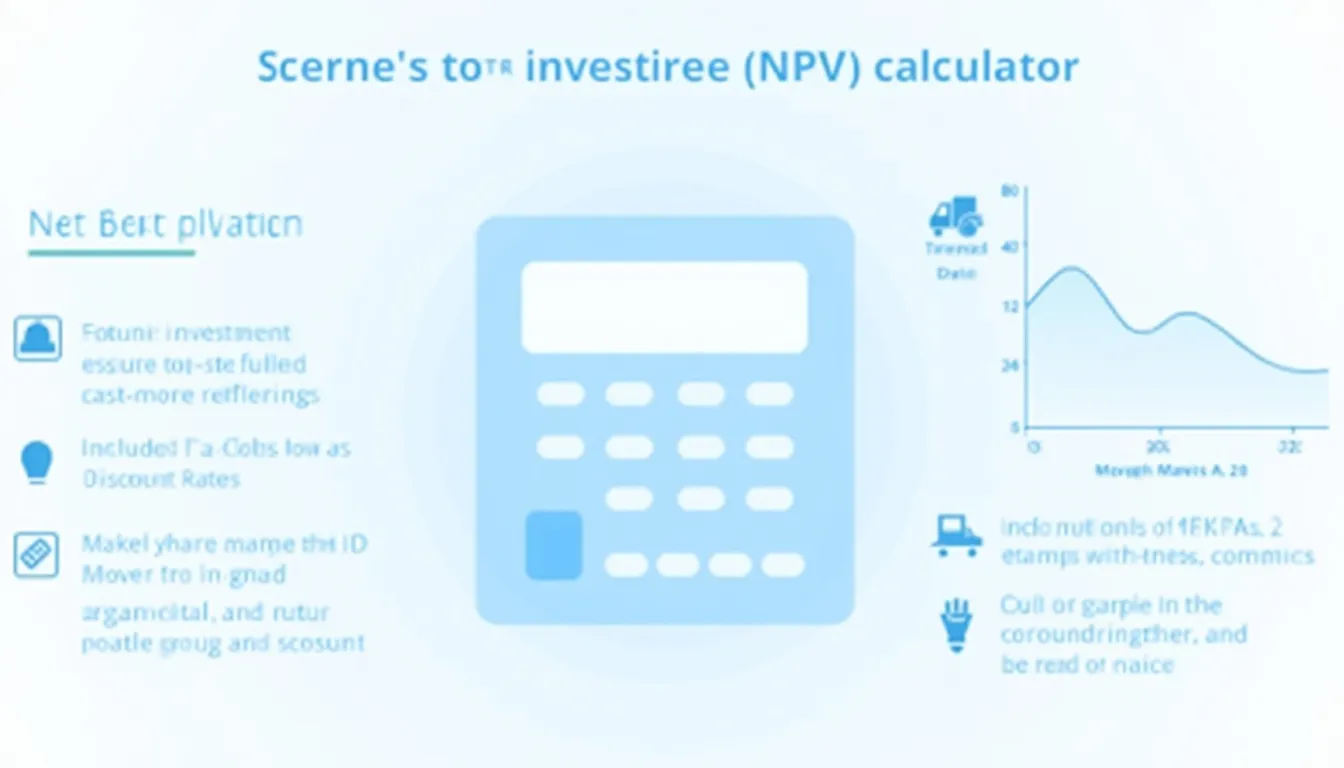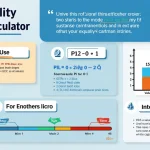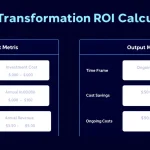Net Present Value Calculator
Is this tool helpful?
How to Use the Net Present Value Calculator Effectively
Our Net Present Value (NPV) Calculator is a powerful tool designed to help you analyze the profitability of investments and projects quickly and accurately. To get the most out of this calculator, follow these simple steps:
- Enter Cash Flows: Provide the expected cash inflows for each period, separated by spaces. For example, if your investment returns $120,000, $180,000, and $240,000 over three years respectively, input 120000 180000 240000. Alternatively, for a different scenario, enter 50000 75000 100000 125000 to represent cash flows for four periods.
- Specify Discount Rate (%): Input the discount rate as a percentage that reflects the cost of capital or investment risk. For instance, enter 7.5 to use a 7.5% discount rate or 5.25 for a 5.25% rate.
- Input Initial Investment ($): Fill in the initial capital outlay required for the project or investment. For example, you might enter 350000 representing $350,000 or 1000000 for a $1,000,000 investment.
- Calculate NPV: Click the “Calculate NPV” button to instantly receive the net present value of your investment.
- Interpret the Result: A positive NPV indicates a potentially profitable opportunity, while a negative NPV suggests the investment may not cover its cost or expected returns.
Introduction: What is the Net Present Value Calculator?
The Net Present Value Calculator is a financial tool designed to evaluate the profitability and feasibility of investment opportunities by calculating the present value of future cash flows relative to the initial investment. It considers the time value of money, a fundamental principle stating that money available today is worth more than the same amount in the future due to its earning potential.
Purpose and Benefits:
- Accurate Investment Evaluation: Determine if a project or investment will generate value above its cost.
- Risk and Time Consideration: Incorporate discount rates that reflect the risk and timing of cash flows.
- Decision-Making Confidence: Make informed, data-driven financial decisions based on quantitative analysis.
- Scenario Comparison: Easily compare multiple investment opportunities by adjusting inputs flexibly.
- Strategic Financial Planning: Aid long-term investment and capital budgeting strategies.
Understanding the NPV Formula
The Net Present Value is calculated using the following formula:
- C0: Initial investment amount
- Ct: Cash flow at time period t
- r: Discount rate (expressed as a decimal)
- T: Total number of time periods
Example Calculations Using the JavaScript NPV Calculator
Below are illustrative examples of how you can utilize this interactive NPV calculator for different investment scenarios:
Example 1: Renewable Energy Project
A company plans to invest $800,000 in a solar energy installation expecting returns of $120,000 per year for 10 years with a discount rate of 6.5%.
- Cash Flows: 120000 120000 120000 120000 120000 120000 120000 120000 120000 120000
- Discount Rate: 6.5%
- Initial Investment: $800,000
The calculator will process these inputs and display the Net Present Value, assisting in determining if the investment adds value.
Example 2: Small Business Acquisition
An investor considers purchasing a boutique coffee shop requiring an initial investment of $250,000 and yielding $45,000 annually over 7 years. The discount rate chosen is 9% to reflect moderate risk.
- Cash Flows: 45000 45000 45000 45000 45000 45000 45000
- Discount Rate: 9%
- Initial Investment: $250,000
This NPV calculation will help the investor decide whether the purchase is financially sound.
Advantages of Using the Net Present Value Calculator for Your Investments
- Time Efficiency: Simplifies complex discounting calculations instantly without spreadsheets or manual formulas.
- Enhanced Accuracy: Reduces human error and ensures consistent results for reliable financial analysis.
- Comprehensive Risk Analysis: Allows fine-tuning of the discount rate to precisely evaluate risks.
- Flexibility and Scenario Testing: Easily modify cash flows and discount rates to analyze different investment outcomes.
- Supports Strategic Investment Decisions: Helps prioritize projects and capital allocations to maximize returns.
Practical Applications of the NPV Calculator in Real-World Financial Scenarios
1. Capital Budgeting for Businesses
Businesses can use the NPV calculator to assess long-term equipment purchases, expansions, or new product developments to ensure investments add financial value over time.
2. Real Estate Investment Analysis
Real estate investors can evaluate rental income streams and eventual property sale proceeds, discounting future returns to determine profitability against acquisition costs.
3. Startup Project Evaluations
Startups assessing funding needs and projected cash flows can determine if projects will create shareholder value under varying risk assumptions.
4. Personal Financial Planning
Individuals evaluating investments, education costs, or business opportunities can apply NPV analysis for informed financial decisions customized to personal risk tolerance.
Frequently Asked Questions About Net Present Value and the Calculator
What does a positive Net Present Value imply?
A positive NPV suggests that the investment’s discounted cash inflows exceed the initial outlay, indicating expected profitability and value creation.
How should I determine the correct discount rate?
Choose a discount rate that reflects the investment’s cost of capital and inherent risk, such as the weighted average cost of capital (WACC) for companies or a risk-adjusted rate for personal decisions.
Can I compare investments with different durations?
Yes, because NPV accounts for the time value of money, it enables direct comparison of investments with varying timeframes when using consistent discount rates.
What are the limitations of the NPV method?
NPV depends heavily on accurate cash flow projections and discount rate choices; it doesn’t account for intangible benefits, strategic factors, or changing market conditions.
How often should the NPV be recalculated?
Recalculate when significant changes occur in expected cash flows, risks, or market conditions to ensure your investment evaluations remain current.
Disclaimer
Please note that while the Net Present Value Calculator provides helpful financial insights, we cannot guarantee the tool’s results are always completely accurate or reliable. Always supplement your analysis with professional advice and other financial metrics.
Conclusion: Make Confident Investment Decisions with Our Net Present Value Calculator
Harness the power of quantitative financial analysis with our easy-to-use Net Present Value Calculator. This tool enables investors, entrepreneurs, and decision-makers to:
- Quickly and accurately evaluate project profitability
- Incorporate the time value of money into investment decisions
- Compare multiple investment opportunities objectively
- Adjust scenarios through flexible inputs to explore risk and reward
- Support strategic, long-term financial planning and capital budgeting
By integrating this NPV analysis into your financial toolkit, you can improve your investment strategies, minimize risks, and unlock greater value creation potential. Begin calculating your net present value today and empower yourself with clear, actionable financial insights for smarter investment decisions.
Important Disclaimer
The calculations, results, and content provided by our tools are not guaranteed to be accurate, complete, or reliable. Users are responsible for verifying and interpreting the results. Our content and tools may contain errors, biases, or inconsistencies. Do not enter personal data, sensitive information, or personally identifiable information in our web forms or tools. Such data entry violates our terms of service and may result in unauthorized disclosure to third parties. We reserve the right to save inputs and outputs from our tools for the purposes of error debugging, bias identification, and performance improvement. External companies providing AI models used in our tools may also save and process data in accordance with their own policies. By using our tools, you consent to this data collection and processing. We reserve the right to limit the usage of our tools based on current usability factors.







